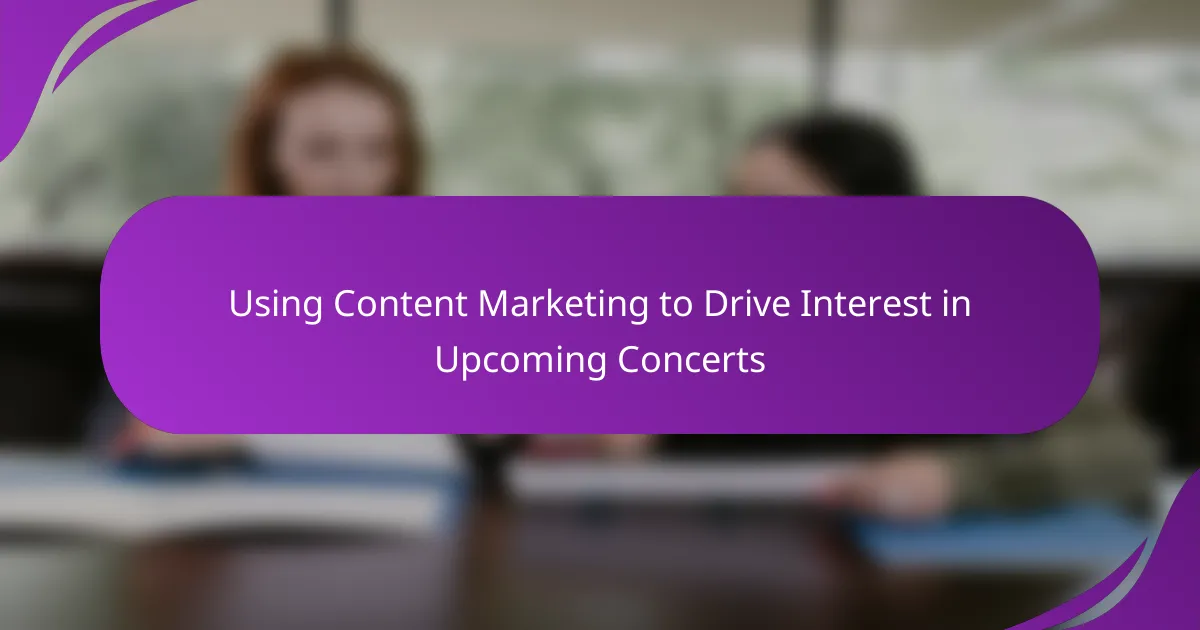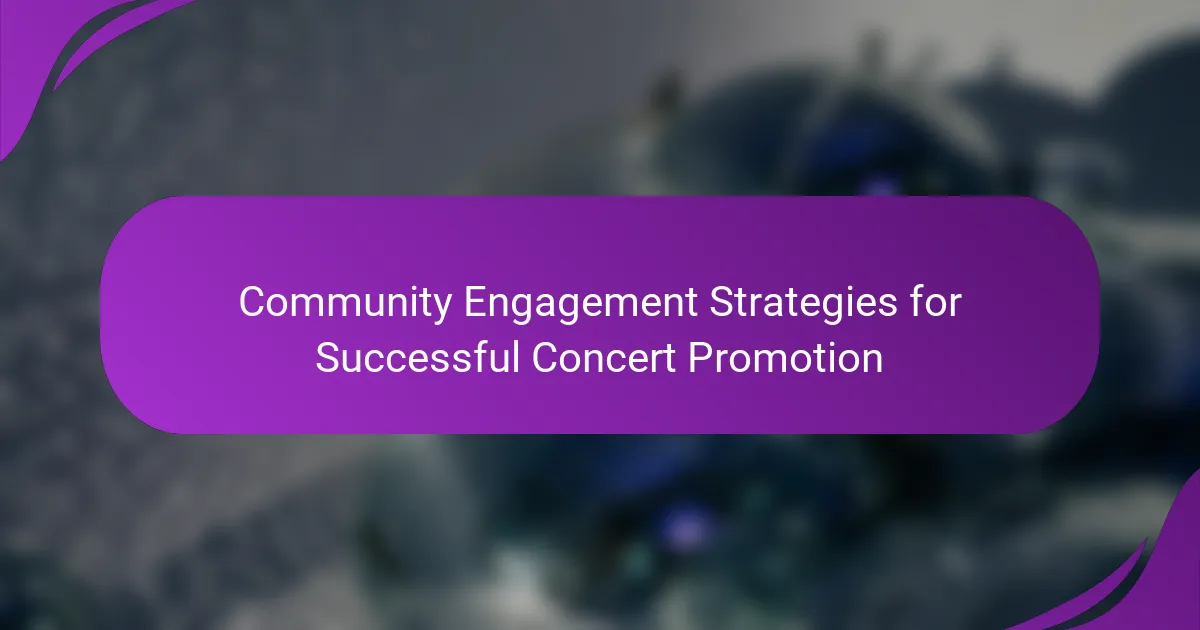Crafting compelling press releases for concert announcements is essential for attracting attendees and ensuring event success. Key elements include a strong headline, a concise lead paragraph detailing the concert’s who, what, when, where, and why, and engaging quotes from artists or organizers. Additionally, important information about ticket sales, pricing, and background on the artists or venue enhances credibility and interest. Effective distribution strategies, including targeting the right media outlets and utilizing multiple channels, are crucial for maximizing visibility and engagement. Common pitfalls to avoid include unclear messaging, lack of essential information, and neglecting proofreading, all of which can hinder the effectiveness of the press release.
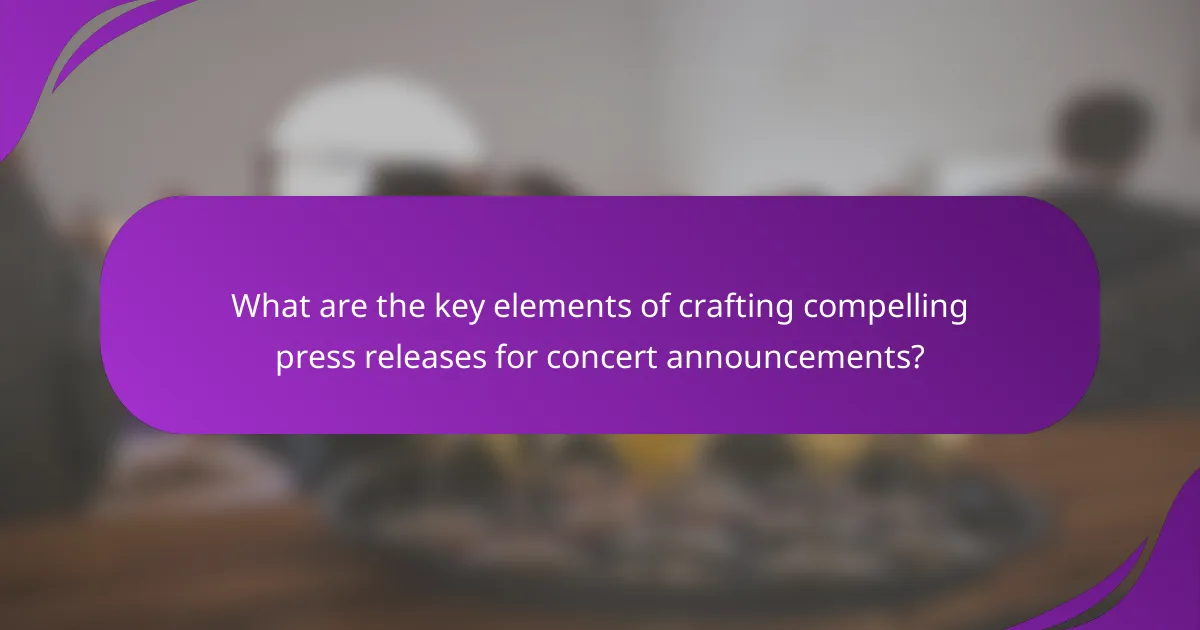
What are the key elements of crafting compelling press releases for concert announcements?
Compelling press releases for concert announcements include several key elements. First, a strong headline captures attention. It should be concise and convey the essence of the announcement. Next, the lead paragraph summarizes the who, what, when, where, and why of the concert. This information should be clear and engaging.
Following the lead, include compelling quotes from artists or organizers to add a personal touch. These quotes enhance the narrative and provide insight into the event’s significance. Additionally, details about ticket sales, pricing, and where to purchase tickets should be included. This information is crucial for potential attendees.
The press release should also contain background information about the artists or the venue. This context helps build interest and credibility. Finally, a strong closing statement encourages action, such as visiting a website for more details or following social media for updates. These elements together create an effective and engaging press release for concert announcements.
How do press releases differ from other forms of communication?
Press releases differ from other forms of communication by being structured documents specifically designed to inform the media about newsworthy events. They follow a standardized format, including a headline, dateline, body, and boilerplate. This structure helps journalists quickly identify key information. Unlike casual communications, press releases focus on delivering factual content in a concise manner. They aim to generate media coverage and public interest. Additionally, press releases are often distributed to a wide audience through press distribution services. This distinguishes them from personal emails or social media posts, which are typically less formal and targeted. The goal of a press release is to provide clear, actionable information to facilitate news reporting.
What purpose does a press release serve in concert promotion?
A press release serves to inform the media and public about a concert event. It generates buzz and attracts attention. The press release includes essential details like date, venue, and ticket information. This information helps journalists write articles and promote the event. Effective press releases can lead to increased ticket sales and audience turnout. They also establish a professional image for the concert organizers. By reaching a wider audience, press releases enhance overall visibility. In 2021, 70% of event promoters reported that press releases significantly impacted their promotional efforts.
Why is it important to craft a compelling narrative in a press release?
Crafting a compelling narrative in a press release is crucial for capturing audience attention. A strong narrative engages readers and encourages them to absorb the information. It helps convey the significance of the event, making it more relatable. A well-structured story can evoke emotions, prompting readers to take action. Statistics show that press releases with compelling narratives receive higher engagement rates. According to a study by Cision, 70% of journalists prefer press releases that tell a story. This highlights the importance of narrative in enhancing visibility and interest.
What components should be included in a press release for a concert announcement?
A press release for a concert announcement should include several key components. First, a compelling headline captures attention and summarizes the event. Next, the dateline provides the release date and location. Following this, an engaging lead paragraph outlines the essential details, such as the artist, venue, and date. The body should elaborate on the event’s significance, including background information about the artist and any special features of the concert. Quotes from the artist or organizers add a personal touch and credibility. Additionally, logistical details like ticket sales information and how to purchase them are crucial. Finally, a boilerplate section gives a brief overview of the organizing entity. Each of these components works together to inform and entice the audience effectively.
What are the essential details to include about the concert?
The essential details to include about the concert are the date, time, and location. The date specifies when the concert will take place. The time indicates the start of the event. The location provides the venue where the concert is held. Additional details include the lineup of performers and ticket information. The lineup informs attendees about the artists or bands performing. Ticket information includes pricing and where to purchase them. This information is crucial for potential attendees to plan their attendance effectively.
How can visuals enhance the effectiveness of a press release?
Visuals can significantly enhance the effectiveness of a press release by capturing attention and conveying information quickly. They create a visual impact that can lead to higher engagement rates. Studies show that press releases with images are 94% more likely to be viewed than those without. Visuals can also help clarify complex messages, making them easier to understand for the audience. Additionally, they can evoke emotions and create a stronger connection to the content. Infographics can summarize data effectively, while videos can provide dynamic storytelling. Overall, integrating visuals fosters better retention of information and increases the likelihood of sharing the press release.
What strategies can be employed to make a press release stand out?
To make a press release stand out, use a catchy headline. A compelling headline grabs attention and encourages further reading. Incorporate relevant keywords for search engine optimization. This increases the likelihood of discovery online. Include an engaging lead paragraph that summarizes the main news. This should answer the who, what, where, when, and why clearly. Utilize quotes from key stakeholders to add credibility and a human element. Visual elements, such as images or videos, can enhance engagement. Distributing the release through targeted media lists ensures it reaches the right audience. Lastly, follow up with journalists to foster relationships and increase coverage chances.
How can headlines be crafted to grab attention?
Headlines can be crafted to grab attention by using strong action verbs, intriguing questions, or compelling statistics. Engaging headlines create curiosity and encourage readers to learn more. For instance, a headline like “Discover the Secrets Behind the Hottest Concerts of 2023” invites readers to explore further. Incorporating numbers, such as “Top 5 Must-See Concerts This Summer,” can also enhance interest. Additionally, using emotional language connects with the audience on a personal level. Research indicates that headlines with emotional triggers increase click-through rates by up to 30%. Lastly, keeping headlines concise ensures they are easily readable and memorable.
What role does the lead paragraph play in engaging readers?
The lead paragraph serves to capture the reader’s attention immediately. It provides essential information about the concert, including the who, what, when, and where. Engaging lead paragraphs often use compelling language to evoke emotion or excitement. This approach encourages readers to continue reading the entire press release. Research indicates that 80% of readers only read the headline and lead paragraph. Therefore, a strong lead is crucial for maintaining interest and driving further engagement.
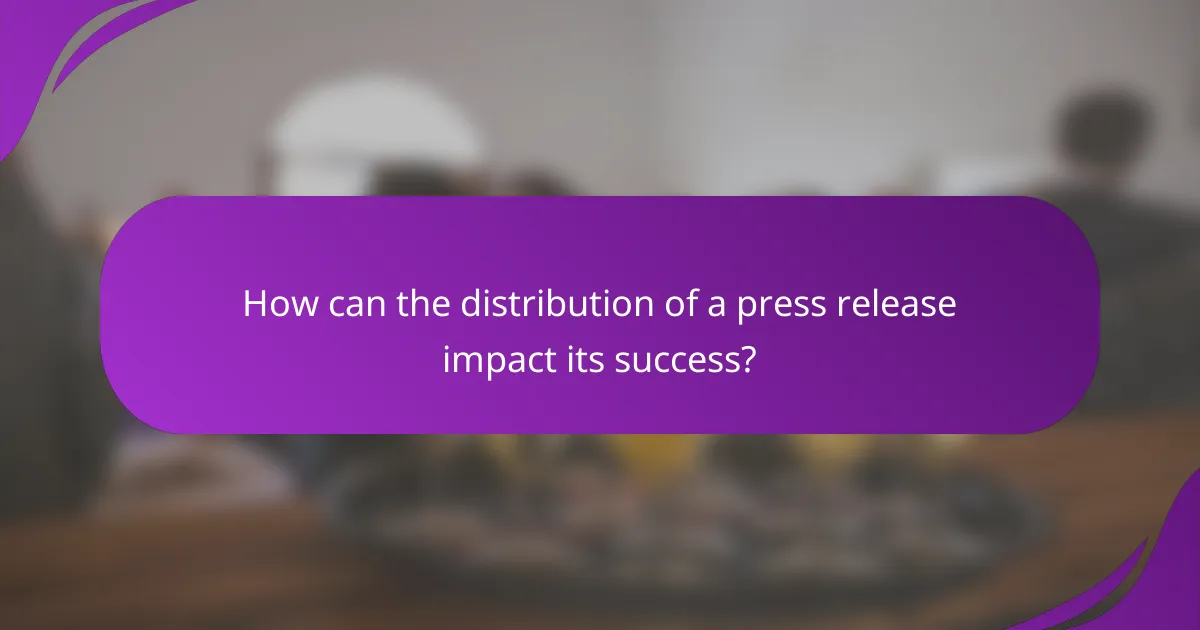
How can the distribution of a press release impact its success?
The distribution of a press release significantly impacts its success. Effective distribution ensures the press release reaches the intended audience. Timing is crucial; releasing it ahead of an event maximizes visibility. Targeting the right media outlets enhances the likelihood of coverage. Utilizing multiple channels, such as social media and email, broadens reach. A well-timed and targeted release can lead to increased attendance at concerts. According to a study by PR Newswire, press releases distributed through targeted channels receive 3.5 times more engagement. Therefore, strategic distribution is essential for achieving desired outcomes.
What channels are most effective for distributing press releases for concerts?
The most effective channels for distributing press releases for concerts include online press release distribution services, social media platforms, and email newsletters. Online press release services, such as PR Newswire and Business Wire, ensure wide reach to journalists and media outlets. Social media platforms like Facebook, Twitter, and Instagram allow direct engagement with fans and targeted advertising. Email newsletters can effectively reach existing subscribers and promote concert details directly. According to a 2022 survey by Cision, 72% of journalists prefer receiving press releases via email, highlighting its importance in distribution.
How can social media be utilized for wider reach?
Social media can be utilized for wider reach by leveraging targeted advertising and engaging content. Platforms like Facebook, Instagram, and Twitter offer tools for demographic targeting. This allows organizations to reach specific audiences based on interests and behaviors. Engaging content such as videos, images, and live streams can capture attention effectively. According to a 2021 report by Hootsuite, social media advertising can increase brand awareness by up to 80%. Collaborating with influencers can also extend reach, as they have established trust with their followers. Utilizing hashtags can enhance visibility and engagement, making posts discoverable to a broader audience.
What are the benefits of targeting specific media outlets?
Targeting specific media outlets increases the effectiveness of press releases. It allows for tailored messaging that resonates with the audience of that outlet. This strategy enhances the likelihood of media coverage. Media outlets often have distinct demographics and interests. By aligning the content with these factors, engagement rates improve. Targeting can lead to higher visibility and reach. For example, a study by the Pew Research Center found that targeted media strategies can increase audience engagement by up to 60%. This demonstrates the tangible benefits of precision in media outreach.
How can timing influence the effectiveness of a press release?
Timing significantly influences the effectiveness of a press release. Press releases need to be distributed at optimal times to maximize visibility. For instance, releasing a press announcement early in the week can capture attention before weekend events. Conversely, late-week releases may get lost in the weekend news cycle. Research shows that 70% of journalists prefer receiving news on weekdays. Additionally, aligning the release with relevant events or trends can enhance engagement. For example, announcing a concert shortly before ticket sales open can create urgency. Effective timing can lead to increased media coverage and audience reach.
What is the best time to send out a press release for a concert?
The best time to send out a press release for a concert is typically two to three weeks before the event. This timeframe allows media outlets sufficient time to cover the announcement. It also maximizes audience awareness and ticket sales. Research indicates that press releases sent within this window receive higher engagement. Timing is crucial as it aligns with journalists’ schedules. Sending too early may result in the news being forgotten. Conversely, sending too late can lead to missed opportunities for coverage. Therefore, two to three weeks is optimal for effective outreach.
How can deadlines and event dates affect press release strategy?
Deadlines and event dates significantly influence press release strategy. Press releases must be timed to maximize visibility and media coverage. For instance, releasing a press release too early may result in diminished interest as the event date approaches. Conversely, releasing it too late can lead to missed opportunities for coverage.
Strategically, aligning the release with major milestones or announcements can enhance engagement. For example, announcing a concert a few weeks prior allows for adequate promotion and audience anticipation. Additionally, integrating deadlines for ticket sales in the press release can create urgency among potential attendees.
Research shows that timely press releases can increase media pick-up rates by up to 30%. This statistic underscores the importance of strategic timing in press release distribution. Overall, effective management of deadlines and event dates ensures that the press release achieves its intended impact.
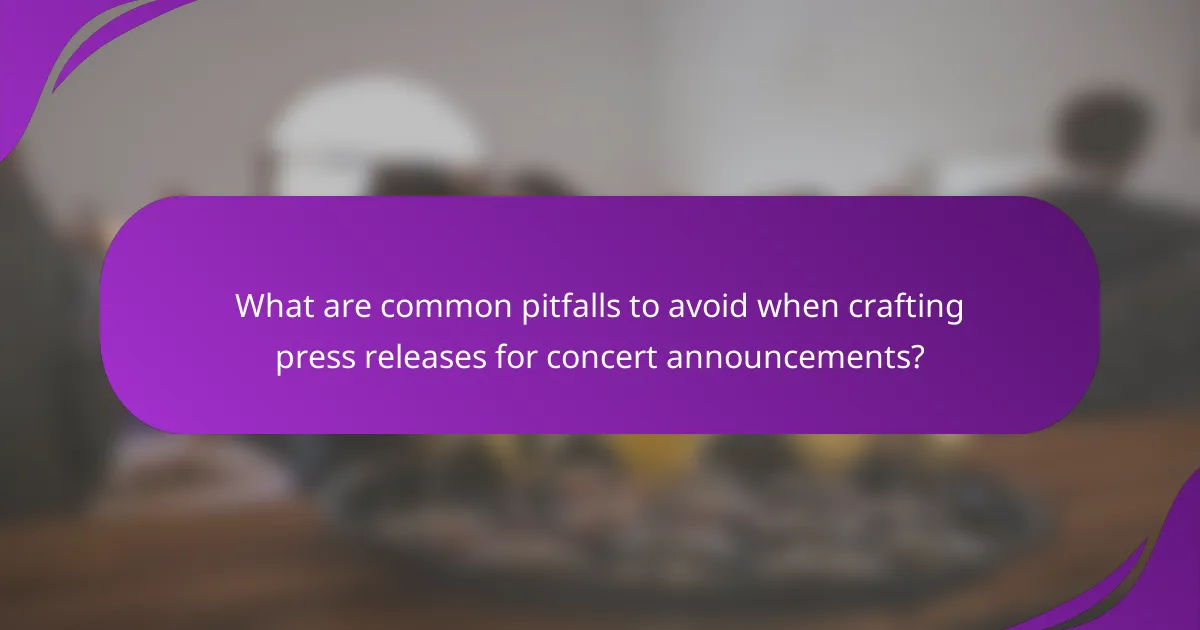
What are common pitfalls to avoid when crafting press releases for concert announcements?
Common pitfalls to avoid when crafting press releases for concert announcements include lack of clarity and excessive jargon. Clear messaging ensures that the audience understands the event details. Overly technical language can alienate potential attendees. Another pitfall is neglecting the importance of a strong headline. A compelling headline grabs attention and encourages further reading. Failing to include essential information, such as date, time, and location, can lead to confusion. Additionally, not providing a call to action may result in missed opportunities for ticket sales. Lastly, overlooking proofreading can lead to errors that diminish professionalism.
What mistakes should be avoided in the writing process?
Common mistakes to avoid in the writing process include lack of clarity, poor structure, and grammatical errors. Clarity ensures the message is easily understood. A well-structured document guides the reader logically through the content. Grammatical errors can undermine credibility. Failing to tailor the content to the audience can lead to disengagement. Overly complex language may confuse readers. Neglecting to include essential information can result in incomplete messages. Lastly, not proofreading can allow mistakes to slip through, affecting professionalism.
How can overly technical language detract from a press release?
Overly technical language can detract from a press release by alienating the audience. Press releases aim to inform a broad audience, including media and potential attendees. When language is too technical, it becomes inaccessible. This can lead to confusion or disinterest among readers. Research shows that clarity increases engagement. A study by the Nielsen Norman Group found that clear language improves comprehension and retention. Therefore, using straightforward language ensures the message is effectively communicated.
What are the risks of neglecting the target audience in messaging?
Neglecting the target audience in messaging can lead to ineffective communication. This results in a disconnect between the message and the audience’s interests. The audience may find the content irrelevant or unengaging. Consequently, this can decrease audience engagement and response rates. Poorly targeted messaging can also damage brand reputation. Brands risk being perceived as out of touch or uninterested in their audience’s needs. Research shows that 70% of consumers prefer personalized messaging. This indicates the importance of understanding the target audience for effective communication.
What best practices can enhance the effectiveness of a concert announcement press release?
To enhance the effectiveness of a concert announcement press release, use a clear and engaging headline. A compelling headline captures attention and summarizes the announcement. Include essential details like date, time, and location early in the release. This ensures that key information is easily accessible. Utilize quotes from artists or organizers to add credibility and a personal touch. Including high-quality images or multimedia can also increase engagement. Distribute the release through multiple channels, including social media and music blogs, to reach a wider audience. Lastly, follow up with journalists to encourage coverage and maintain relationships. These practices can significantly improve visibility and audience interest in the concert.
How can proofreading and editing improve the final document?
Proofreading and editing enhance the final document by eliminating errors and improving clarity. These processes ensure grammatical correctness, which boosts professionalism. They also help refine the message, making it more persuasive. A well-edited document engages readers effectively. Research indicates that clear communication increases audience retention by up to 70%. Additionally, proofreading can catch inconsistencies that may confuse readers. Overall, these practices lead to a polished and impactful final product.
What tips can help ensure clarity and conciseness in the message?
Use simple language to enhance clarity. Short sentences improve readability. Avoid jargon that may confuse the reader. Focus on key messages to maintain conciseness. Eliminate unnecessary words that do not add value. Use active voice for direct communication. Organize content logically to guide the reader. Proofread to catch errors that could obscure meaning.
What are the key takeaways for crafting successful concert announcement press releases?
Key takeaways for crafting successful concert announcement press releases include clear and concise headlines. Headlines should grab attention and convey essential information. Include the who, what, when, where, and why in the first paragraph. This ensures that the most critical details are communicated upfront. Use quotes from the artist or promoter to add a personal touch and credibility. Incorporate compelling visuals to enhance engagement. Ensure the press release is distributed through appropriate channels to reach the target audience effectively. Finally, proofread for accuracy and professionalism to maintain credibility.
The main entity of the article is ‘press releases for concert announcements.’ The article outlines the essential components of crafting effective press releases, including strong headlines, engaging lead paragraphs, and the inclusion of relevant quotes, ticket information, and background details about artists or venues. It emphasizes the importance of clarity, audience targeting, and strategic distribution to maximize visibility and engagement. Additionally, the article discusses the role of compelling narratives, visuals, and timing in enhancing the effectiveness of press releases, while also highlighting common pitfalls to avoid in the writing process.
